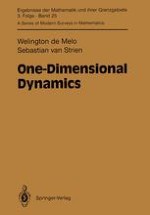One-dimensional dynamics has developed in the last decades into a subject in its own right. Yet, many recent results are inaccessible and have never been brought together. For this reason, we have tried to give a unified ac count of the subject and complete proofs of many results. To show what results one might expect, the first chapter deals with the theory of circle diffeomorphisms. The remainder of the book is an attempt to develop the analogous theory in the non-invertible case, despite the intrinsic additional difficulties. In this way, we have tried to show that there is a unified theory in one-dimensional dynamics. By reading one or more of the chapters, the reader can quickly reach the frontier of research. Let us quickly summarize the book. The first chapter deals with circle diffeomorphisms and contains a complete proof of the theorem on the smooth linearizability of circle diffeomorphisms due to M. Herman, J.-C. Yoccoz and others. Chapter II treats the kneading theory of Milnor and Thurstonj also included are an exposition on Hofbauer's tower construction and a result on fuB multimodal families (this last result solves a question posed by J. Milnor).
